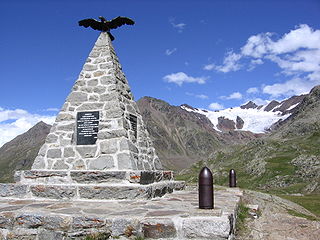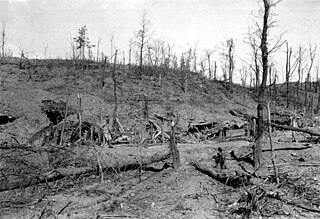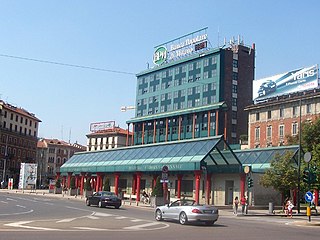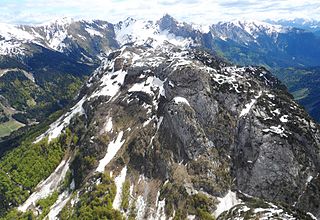
Asiago is a minor township with the title of city in the surrounding plateau region in the Province of Vicenza in the Veneto region of Northeastern Italy. It is near the border between the Veneto and Trentino-Alto Adige/Südtirol regions in the foothills of the Alps, approximately equidistant (60 km) from Trento to the west and Vicenza to the south. The Asiago region is the origin of Asiago cheese. The town was the site of a major battle between Austrian and Italian forces on the Alpine Front of World War I. It is a major ski resort destination, and the site of the Astrophysical Observatory of Asiago, operated by the University of Padua.

The Battle of San Matteo took place in the late summer of 1918 on the Punta San Matteo during World War I. It was regarded as the highest battle in history until it was surpassed in 1999 by the Kargil Conflict at 5,600 m.

Carlo Orelli was, at age 110, the last surviving Italian World War I veteran who joined the army at the onset of the war. Born in Perugia, although he lived in Rome for most of his life, Orelli came from a military family whose members had served in various Italian conflicts since 1849. A mechanic by trade, Orelli joined the Italian Army in May 1915 and engaged in combat operations in Italy. His recollections were marked by particularly brutal experiences of trench warfare, including the violent deaths of many of his friends. After receiving injuries to his leg, he was pulled from active duty and returned home.

A serac is a block or column of glacial ice, often formed by intersecting crevasses on a glacier. Commonly house-sized or larger, they are dangerous to mountaineers, since they may topple with little warning. Even when stabilized by persistent cold weather, they can be an impediment to glacier travel.

Marmolada is a mountain in northeastern Italy and the highest mountain of the Dolomites. It lies between the borders of Trentino and Veneto. The Marmolada is an ultra-prominent peak (Ultra), known as the "Queen of the Dolomites". In 2009, as part of the Dolomites, the Marmolada massif was named a UNESCO World Heritage site.

The First Battle of the Isonzo was fought between the armies of Italy and Austria-Hungary on the northeastern Italian Front in World War I, between 23 June and 7 July 1915.

The Südtirol Offensive, also known as the Battle of Asiago or Battle of the Plateaux, wrongly nicknamed Strafexpedition "Punitive expedition", was a major offensive launched by the Austro-Hungarians on the territory of Vicentine Alps in the Italian Front on 15 May 1916, during World War I. It was an "unexpected" attack that took place near Asiago in the province of Vicenza after the Fifth Battle of the Isonzo.

Predazzo is a village and comune in the province of Trento, northern Italy. Predazzo is located about 58 kilometres northeast of Trento in Val di Fiemme.

The Great War is a 1959 Italian comedy-drama war film directed by Mario Monicelli. It tells the story of an odd couple of army buddies in World War I; the movie, while played on a comedic register, does not hide from the viewer the horrors and grimness of trench warfare. Starring Alberto Sordi and Vittorio Gassman and produced by Dino De Laurentiis, the film won the Golden Lion at the Venice Film Festival. Its crew also included Danilo Donati (costumes) and Mario Garbuglia.

The 10.4 cm Feldkanone M. 15 was a heavy field gun used by Austria-Hungary in World War I. It was derived from the successful 15 cm schwere Feldhaubitze M 14 modified to fire high-velocity 104-mm projectiles.

Milano Cadorna is a commuter railway station located near the Castello Sforzesco in Milan, Italy.
SS Minas was an Italian troopship which was sunk on 15 February 1917 in the Central Mediterranean Sea with the loss of 870 lives.

Tre Sassi fort is a fortress and museum on the road to the Passo di Valparola, within the comune of Cortina d'Ampezzo in the southern (Dolomitic) Alps of the Veneto region of Northern Italy. Hidden between the Ampezzo valley and the high Val Badia, it was built by Austrians between 1897 and 1901 as a fortification against attack from the Italians on the Falzàrego and Valparo. During World War I it was a favorite target for the Italians, and the fort was destroyed as there was inadequate artillery to defend it.

Luigi Bongiovanni (1866–1941) was an Italian general. He was a governor of Cyrenaica from December 1922 to May 1924

White Friday occurred during the Italian front of World War I. The most significant avalanche struck the Austro-Hungarian barracks on Mount Marmolada, killing 270 soldiers. Other avalanches on the same day would strike Italian and other Austro-Hungarian positions, killing hundreds. According to some reports, both sides deliberately fired shells into the weakened snowpacks in an attempt to bury the other side.

The White War is the name given to the fighting in the high-altitude Alpine sector of the Italian front during the First World War, principally in the Dolomites, the Ortles-Cevedale Alps and the Adamello-Presanella Alps. More than two-thirds of this conflict zone lies at an altitude above 2,000m, rising to 3905m at Mount Ortler. In 1917 New York World correspondent E. Alexander Powell wrote: “On no front, not on the sun-scorched plains of Mesopotamia, nor in the frozen Mazurian marshes, nor in the blood-soaked mud of Flanders, does the fighting man lead so arduous an existence as up here on the roof of the world.”

Between the 1860s and the First World War the Kingdom of Italy built a number of fortifications along its border with Austria-Hungary. From 1859 the fortified border ran south from Switzerland to Lake Garda, between Italian Lombardy and Austrian South Tyrol. After 1866 it extended to include the border between South Tyrol and Veneto, from Lake Garda to the Carnic Alps. This frontier was difficult to defend, since Austria-Hungary held the higher ground, and an invasion would immediately threaten the industrial and agricultural heartlands of the Po valley. Between 1900 and 1910, Italy also built a series of fortifications along the defensive line of the Tagliamento to protect against an invasion from the northeast. The border with Switzerland was also fortified in what is known as the Cadorna Line.

On 3 July 2022, a serac collapsed on the mountain of Marmolada, in the Dolomites at the regional border between Trentino and Veneto, Italy. Eleven people were killed and eight were wounded. The large-scale collapse of the serac led to one of the most serious accidents in the Alps in decades. The seismic energy released was comparable to an earthquake of 0.6 M.

The Pal Piccolo is a mountain in the Carnic Alps, located near Plöcken Pass, on the border between the Italian region of Friuli-Venezia Giulia and the Austrian state of Carinthia. It has an elevation of 1,866 metres.

Dente Italiano is one of the ridges of the Pasubio summit highlands in the Vicentine Alps.























